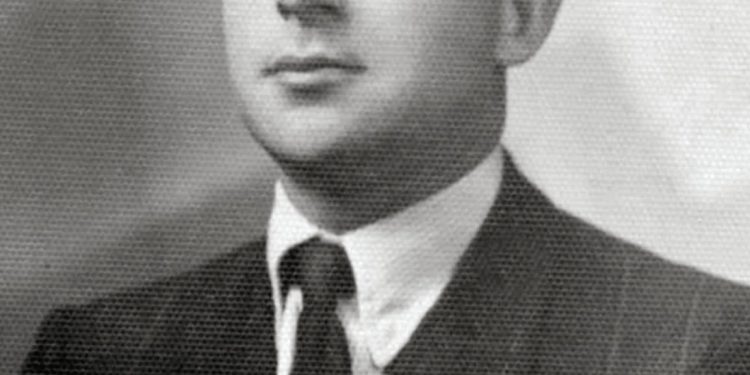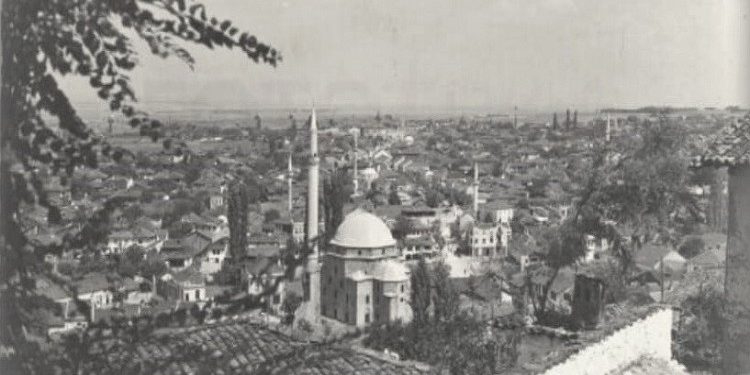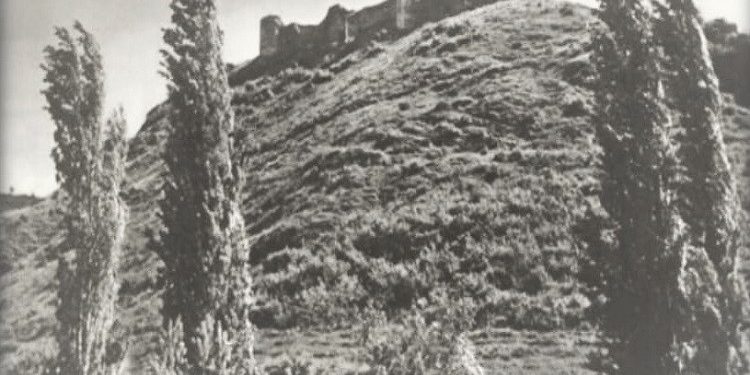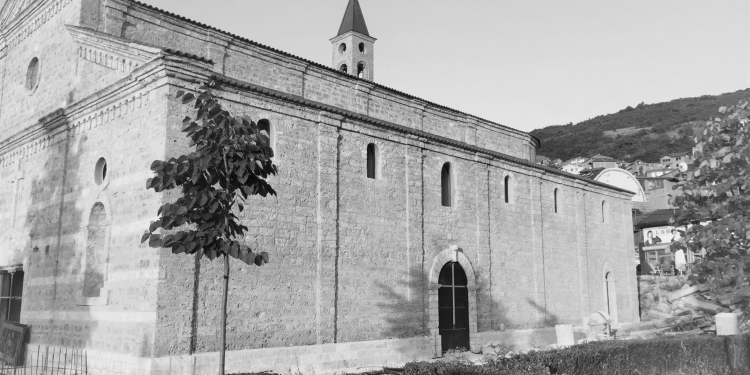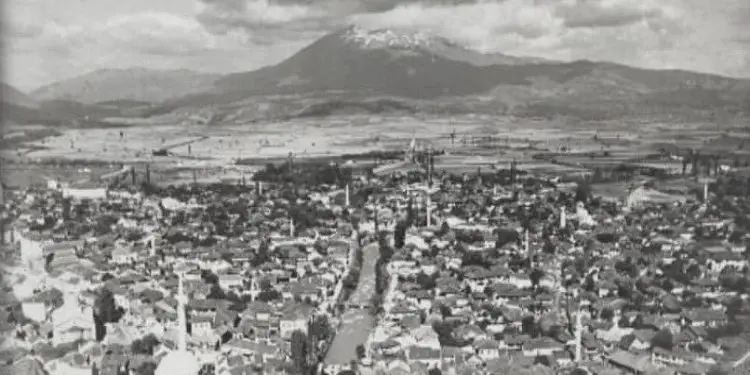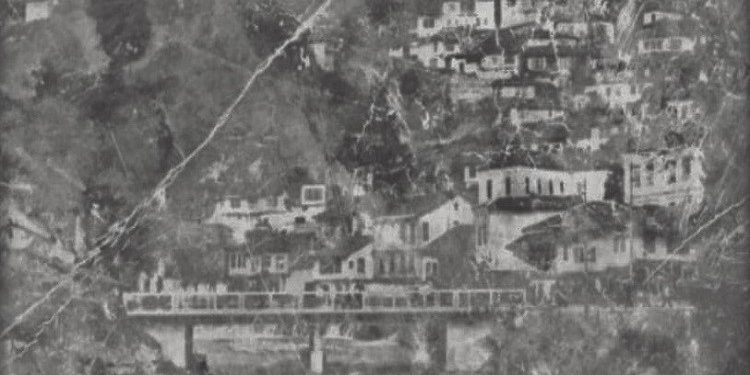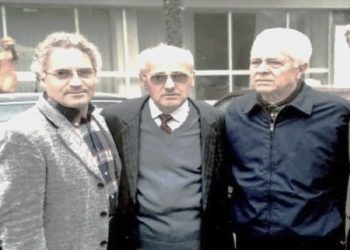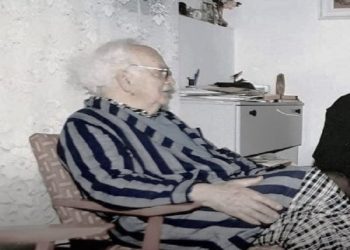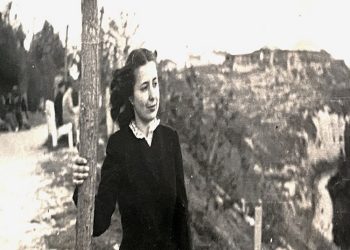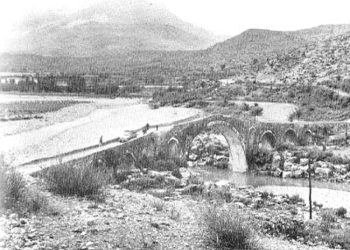By Mitrush Kuteli
IN PRIZREN, AMONG THE DEAD AND THE LIVING
Memorie.al / If you happen to come to Prizren-for a purpose clearer than smuggling-after you’ve enjoyed the unique beauty of this quiet place and the joys of the living, don’t forget to visit the dwellings of the dead. All the tall men and all the graceful maidens and ladies you admire as they stroll there by the Shatrivan (Fountain), or at the foot of the Sinan Pasha Mosque, or over the Stone Bridge, are a drop in the ocean compared to the number of those resting beneath the earth.
I don’t know if they, where they are and where they are not, feel our step, or if they have any joy, in their own way, but I know that our soul emerges from these parades to the final resting place, more worn out, more humane, and perhaps further removed from the vanities of the earth. Ah, it is very difficult to visit all the graves of such a large and old city, as they are numerous and scattered. And many traces have vanished. But we do what we can.
Come, let us cross together the Stone Bridge with Venetian arches, there near the Sinan Pasha Mosque, and go slowly, through some very narrow and winding streets (I like these more than the monotonously straight, cord-drawn streets of new cities), as far as the Bajrakli Mosque.
In front of this Mosque with its surprisingly slender minaret, like a reed stalk, there is a courtyard, and in the courtyard some old graves of ladies and gentlemen, from the powerful of a certain time. Now, when no hand reaches out to tend to them, neither the graves nor the nearby corner, the marble slabs have fallen down, trodden upon and ground by time.
I would very much like to read the inscriptions, with that fantastic Arabic calligraphy that none of the stiff European alphabets can approach in beauty. But I don’t know how, and I am desperate that perhaps I will never know. Nevertheless, I like to observe them and touch them with my fingers. Because it seems to me that when I touch these works of sculptural art with my fingers, I get closer to the spirit of the artist who crafted them.
Look, all the dead here sleep under the complicated sign of the Aryan swastika in the form of a sun, which the living once brought with fanfare and tears. Then it was their turn to leave this world-as it will be ours, tomorrow-and they were left desolate. It is good to stay a few hours here in the courtyard of Bajrakliu (and I have stayed many times), as the water of the fountains and the murmur of the stream bring peace, but today we have more wandering to do.
We descend, without any apparent destination, through the arabesque of the city streets, which God gifted with much water. Look here, a large gate with a star and a crescent moon above it. The gate is open. There is no one to ask. We peer through a window. “Inside are graves-there are six-with heavy skullcaps and turbans on top. And right next to them is a dwelling / Here is life-there is death.”
How quiet the courtyard is! A fountain, with clear water, under a pergola. A blooming rose, a bird singing. We are in the month of May…! A man passes by. I ask, and he answers: “The first graves are the graves of strangers, friends of the Teqe (Dervish lodge) whom death reached here. The other graves belong to the fathers of the Teqe, starting with Sheh Osmani, and after him, Sheh Ahmeti, Sheh Sinani, and four others.” Here too, the peace of God tells you: stay. But we are travelers and we leave.
From there, by the river, the Church of Shën Spas (Holy Savior) or the Church of the Gogs (Vlachs), as the people call it, can be seen on a hill. This has its history. The Serbs have burned it several times during the time of the Turk, because the Vlachs did not accept the Serbian language in the church. There are some old graves there, with Greek inscriptions, which can serve as historical documents to prove that the greater part of the Serbian population of Prizren is, in reality, a Serbianized Albanian-Romanian population through the church, and which, once, wanted to live its own national life.
The City of Tears and Flowers
The new, current graves of Prizren are beyond, at the entrance to the city. To get there, we keep to the right bank of the river. Don’t stop too long this time on the bridges to watch the frothing water flow below, or the numerous mills. Without a doubt, these are better than that of Xha Braho of Shkumbana. They have five or six millstones. But we will come another time to step on them. We reach the last bridge—a wooden bridge. We must cross it.
Look there, to the right, a large field of graves: The graves of the Muslims. Steep slabs of gray stone. Most without head-inscriptions. Some that do have them are in Arabic. The grass is green, fresh, but we can pass through because the sun drank the morning dew. There, under a shadow, a man sleeps: peaceful, with his hands beneath his head, next to a stone. As he will sleep there tomorrow, but beneath the ground, forever.
The graves of the Orthodox, beneath the blooming locust trees. These graves of the Serbian bourgeoisie, who dominated in recent years, are well cared for. Stones with golden letters, flowers, photographs. Many women, dressed in black, are bustling about. I initially believed there might be a funeral, but no. Today is Saturday of the Dead, May 22, 1943. Many wails and tears. This is Orthodoxy: mystical, sentimental, lachrymose.
There, next to a fresh grave, a young woman has collapsed and is weeping, exhausted, overwhelmed. Beyond, some others, with noise. Some women struggle to lift a weeping old woman from the ground, advising her and repeating the litany “dushe moje, dushe, dushe, dushe” (“my soul, soul, soul, soul”). Another addresses her son, who is wasting away inside, with one Serbian word and one Albanian: “sine – bir-o! sine – bir-o!” She cries despairingly. She is, without a doubt, some Albanian or some Romanian (Vlach) from Albania (many of the Gogs of Prizren came from the Korça and Monastir districts), now Serbianized, but who calls her dead son in the old language “bir-o.”
Today is full of sobs, and we might weep remembering our dead, even though the locust tree is blooming and the sparrows sing. Yes, the sparrows sing among the graves…! A toddler in black passes by, led by a mother all in black. What a terrible color this black is! The lady weeps, and the toddler looks at the sparrow singing there on the branch, because she does not know the pain of true tears.
Let us leave the Orthodox graves with heavy Cyrillic inscriptions on top. So many Serbianized nationalities sleep within. We move further and cross the green boundary that separates the Orthodox graves from the Catholic graves. Yes, only a green line, while the graves of Shkodra need to be surrounded by walls and iron gates, with heavy padlocks.
Ah, here in the graves of the Prizren Catholics, there are Albanian inscriptions! Albanian-in the time of Turkey and Serbia! This is a decisively and courageously written Albanian affirmation on stone, which we must underline with visible colors, as one of the expressions of national consciousness. Known names: Shirokanj, Mjedanj, and others.
Balta and Filja: The Tragedies on Stone
Look, a quite ancient grave, with a heavy cross. And on the cross an inscription: “Këtu pushojnë Balta e Mana Tarabolluzi të mbytun prej Lumjanve më 2 Tetuer 1880” (Here rest Balta and Mana Tarabolluzi killed by the Lumjanë on October 2, 1880). They also have their photographs there. Balta in a Gjiritli costume, with wide black trousers; Mana in local dimi (traditional pants).
I asked in the city about the tragedy of Balta and Mana: Balta was a great merchant (his ruined house is there, near the Catholic church). And brave. He had a quarrel with Destan-the-policeman, over a bequeathed gold necklace. Destani brought the Lumjanë people to kill him. They surrounded the house at night. Balta and Mana, husband and wife, “had fired the gun” with such great bravery that the song is still sung about them today in Prizren:
“Mana mush e Balto qit/
I Madhi Zot mos na korit/
Moj Mane, moj krajlicë/
Na kallshe ç‘at dite/
Se kan ardh cubat me të mbytë”
(Mana load and Balto fire /
May the Great God not put us to shame /
Oh Mana, oh queen /
You set us alight that day /
For the bandits have come to kill you)
They fought bravely, but the Lumjanë were many, and Destan-the-policeman himself had brought them. One Lumjan fell in the courtyard, one inside in the wool (because Balto also traded in wool), and another, I don’t know where. Several were wounded. But finally, both Balta and Mana fell killed…! Now their house is desolate. They were left with nothing but the song. And the song is enough. Will more remain of us?
But look, there, another grave, surrounded by iron railings. The grave grass is fresh, large, cared for. On the cross is the photograph of a young maiden. A mythical beauty, with noble, aristocratic lines. I kneel and read: “këtu pushon Filja e Ukës Zef (Toçes). Leu më 16 Tetuer 1901, diç më 29 Shtatuer 1921” (Here rests Filja, daughter of Ukë Zef (Toçe). Born October 16, 1901, died September 29, 1921). Not yet twenty years old! And so beautiful!
Below are some well-crafted verses on stone, in that old Albanian of the North:
“N‘kohë ma t‘mirën t‘vajzniis,
Filja e Ukës sod ndroj jetë;
Tuj kenë shembulli i pastriis,
Vllaan e nanën shkoj me gjetë.
Ku e pata ket rrezik,
Me i mblu baba fëmit n‘dhe
Me ditë t‘soçme un jam fikë,
E nuk m‘met asnji për bee.”
(In the best time of her maidenhood,
Filja of Ukë changed life today;
Being an example of purity,
I go to find my brother and mother.
Where did I find this danger,
For my father to cover his children in the ground
With today’s knowledge, I am extinguished,
And not one soul is left to swear by.)
The last stanza is the most moving of all, but it is covered by fresh grass, right at the foot of the cross. The deceased herself speaks: “T‘lutem Babë mos m‘u idhnue/ Malli i Vllaut fort m‘ka mollies” (I beg you, Father, do not be angry with me / The longing for my Brother has made me very soft)! Ah, again the grass covers the letters. Not only the grass, but also a spark that flashes in my eyes. Is it the echo of those wails coming from beyond, from the Orthodox graves, or the painful word of this Filja e Ukës? Or the true beauty of the verse?
It continues: “Te nanë zeza du me shkue/ Me dite t‘soçme t‘kam braktisë/ U dhemb, lexues, u dhemb” (To the dark mother I want to go / With today’s knowledge I have abandoned you / Does it hurt you, reader, does it hurt)? Neither I nor you know who Filja e Ukës from Prizren was. And we have no connection with them. But the maiden was young, very beautiful, and her word is sorrowful…!
Life and the Moving Garden
Now let us leave the cemeteries and return to the city and wait for the evening. It is then, when the mountains of Small Albania glow red in the fire, that the maidens of Prizren come out to stroll there at the Shatrivan, at the Sinan Pasha Mosque, and as far as the Stone Bridge with Venetian arches. Without a doubt, Filja e Ukës, who is now ash and earth, is not among them, but these others, her Prizren sisters, are also very pleasant to look at.
A woman who knows how to dress beautifully, with nobility, and to tread lightly, is a gift from God. A graceful garment that complements the natural beauty of a woman is also a gift from God. And Prizren has both: beautiful ladies and young ladies who know how to dress beautifully, walk with grace, and wear graceful garments.
The characteristic clothing is the çitjanja (trousers), brought by the Turk and adapted by all the elements of the region: Muslims, Orthodox, Catholics. Each of these categories has brought the distinctiveness of its own feeling, making a typical garment a specific one.
In beauty, the Catholic dress reigns supreme, the dimija (as the ladies there call it), completed with a shawl to tie the hair, with a parlant (sash), and with the woolen wrap thrown over the shoulders. All in the strong colors of spring: very deep red, very deep green. And all these colors mixed together, in the form of flowers and arabesques, make them like a walking flower garden, a strolling gyulistan (rose garden) that amazes and captivates.
Look, reader, forget the graves and look there in the Shatrivan: Three ladies or young ladies descend slowly toward the Bridge. The one on the right and the one on the left, in European costumes. Well-dressed, correct, and they walk beautifully. They are also graceful. And they have a lot of nobility in their gait and appearance. But they do not attract our gaze except in a secondary and tertiary manner.
Because between them is a queen dressed in the local costume, who drove the entire Shatrivan crazy. And I wonder how this Abdyl Be Frashëri of the League of Prizren endures and stays put, perched on the stone…! It is a gyulistan that walks majestic, dominant, captivating. And if you have a soul, you feel like making a carpet of flowers and spreading it at her feet.
In the evenings, I return home alone. Ah, I am not alone, because my shadow follows me, gets ahead of me, slides right, left, on the walls of the courtyards. It is neither strange nor fortunate to have your shadow with you, but remember that the sad hero of Adalbert von Chamisso no longer had it and was utterly miserable.
In front of me, a group of Catholic ladies and gentlemen walk slowly, as if to a wedding. And indeed, they are going to a wedding, singing: Qit-mi, Nan se due me-i vesh (Dress me, Mother, for I want to wear them), and further: Du me dal mun‘ ke dera (I want to go out by the door)…! And the song is beautiful, and the voices are sweet, and the lights play now and then upon their dimi and their woolen wraps. And windows open, and doors open to watch, to listen.
But a wave of pain now possesses me. And not for my life, which became frayed in exile, nor for the unknown dead I spoke of earlier. But for this Albania of mine that sings here, and cries beyond…! / Memorie.al
May, 1943 Prizren




